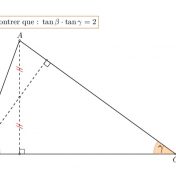Géométrie plane et nombres complexes
Dans un parallélogramme, la somme des carrés des diagonales égale la somme des carrés des côtés. Si les longueurs des côtés sont notées \(L\) et \(\ell\) et les longueurs des diagonales sont \(D\) et \(d\) alors il s’agit de montrer l’égalité $$D^2+d^2 = 2\ell^2+2L^2.$$ Cela devient simple si l’on considère que notre parallélogramme a pour sommets \(0\), \(z\), \(z’\) et… Read more »

